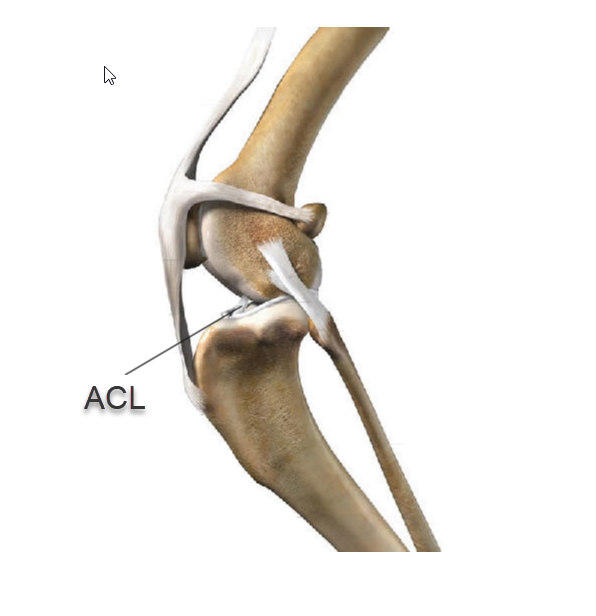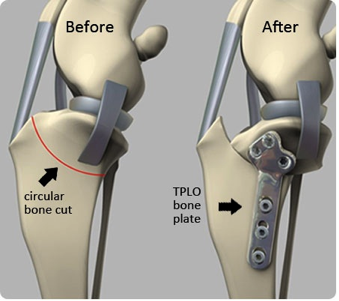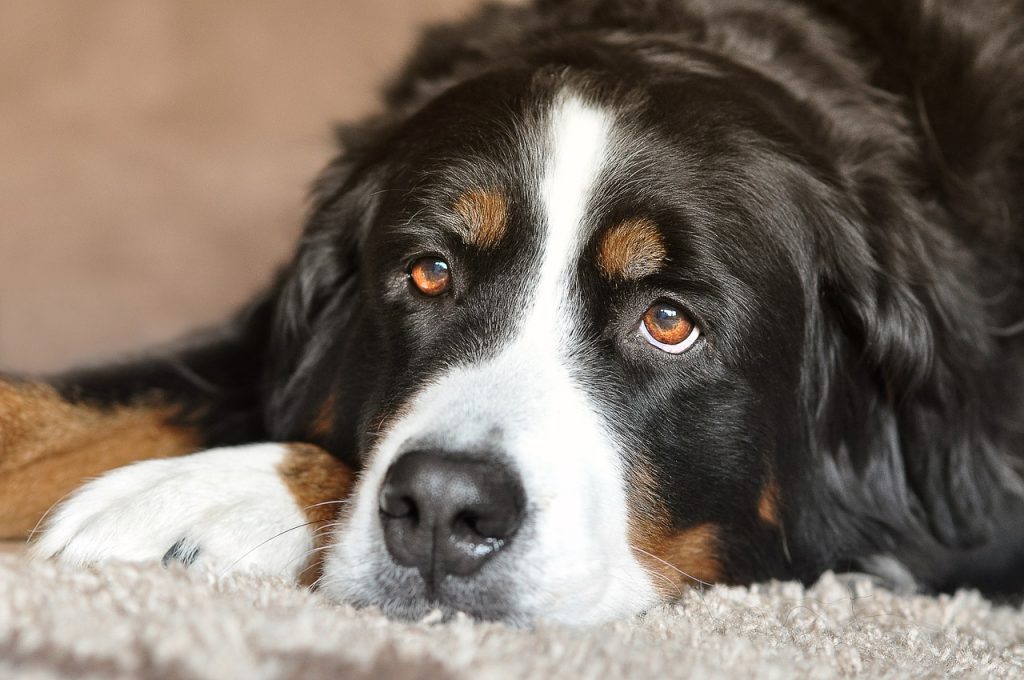ACL surgery is one of the most common orthopedic surgeries performed in veterinary medicine. Dog ACL surgery is indicated when a dog tears its anterior cruciate ligament (ACL). The goal of the surgery is to help stabilize the knee joint, preventing early-onset arthritis.
ACL Tear in Dogs
Knee injuries are the most common orthopedic injuries in dogs, with ACL tears accounting for a large percentage of these injuries. The ACL gets damaged when it stretches or tears. This is most commonly a degenerative process in dogs but may also happen acutely when your dog turns sharply, or moves suddenly, while they’re running or jumping.
If your dog’s ACL gets damaged, they may have trouble putting pressure on their back leg, walking, jumping, or playing. It may also seem to get better initially, but never fully resolve. This is because the ACL stabilizes the knee, and when it is torn, the knee is no longer stabilized very well.

The following article will outline a typical timeline for recovery from surgery, with appropriate exercises for each stage of healing. Your timeline and rehabilitation plan may differ from the plan below, so always seek the advice of your vet before starting any rehabilitation program.
ACL Surgery in Dogs
There are numerous surgical repair techniques used for ACL injuries in dogs. Different vets will perform different techniques based on their training and the suitability of your dog, so please don’t hesitate to ask your vet questions about the technique they’re recommending.
Some of the surgical options for ACL injury are:
- TPLO (Tibial Plateau Levelling Osteotomy)
- Extracapsular (DeAngelis) Repair
- TTA (Tibial Tuberosity Advancement)
- CBLO (CORA-levelling Osteotomy)

If you would like more information on the individual surgical techniques please read our article here.
The post-surgical plan below is based on TPLO surgery being performed. It is meant to give you an idea of what to expect post-surgically so that you can be prepared. Always speak to your vet about a plan that suits your dogs individual recovery.
Day 1 – 14 Following Dog ACL Surgery
- Icing (cryotherapy) – Ice your dog’s knee twice daily for 20 minutes per session. Wrap the ice pack in a towel before applying.
- Strict crate rest – Ideally your dog will be crated, but if your dog is confined to a small room please ensure the floor is non-slip. This can be achieved with off-cuts of carpet, foam floor squares or rubber matting. Your dog should only be allowed out of their crate if you’re working with them (ice, walking, toileting, exercises)
- Toilet breaks – on lead (short), slow controlled walk out to the toilet. If you have to walk across slippery floors, (e.g. tiles, floorboards) or up / down stairs, please support your dog under their abdomen with a towel or harness (e.g. help em up harness).
- Walking protocol – slow and controlled on lead only. Must be slow enough to encourage your dog to place the foot of their post-surgical leg on the ground
- Week 1 – only out to the toilet as needed
- Week 2 – 5 minutes per day (on top of the toilet breaks)
- Exercises – The objective is to promote the use of your dogs post-surgical knee. For more information on the individual exercises (with videos) click here. 10 repetitions, 2-3 times per day
- Weight shifting
- Weight-bearing / three-point stand
Weeks 3 – 4 Following Dog ACL Surgery
- Strict crate rest – this must continue when you aren’t doing exercises with your dog. The bones still haven’t healed so we only want controlled exercise to be taking place.
- Walking protocol – slow and controlled on lead. All toilet trips still on lead.
- Week 3 – 10 minutes per day (on top of the toilet breaks)
- Week 4 – 15 minutes per day (on top of the toilet breaks)
- Exercises – the objective continues to be promoting the use of the post-surgical leg, with a progression to include basic strengthening. For more information on the individual exercises (with videos) click here. 10 repetitions, 2-3 times per day. Progress duration of holds.
- Weight shifting
- Three-point stand
- Front feet up
- Hydrotherapy – An underwater treadmill can be an invaluable part of a complete rehabilitation program post ACL surgery. Typically this will start 3 weeks after surgery, once your dog’s stitches have been removed.
Weeks 5-6 Following Dog ACL Surgery
- Strict crate rest – continues
- Walking protocol – slow and controlled on lead. If your dog is able to walk with a normal gait (not limping), you can also start to incorporate some hill walking (progressively).
- Week 5 – 2 x 10 minutes per day (i.e. 20 minutes in total)
- Week 6 – 1 x 10 minutes + 1 x 15 minutes per day
- Exercises – if normal use of the post-surgical leg has been achieved, the focus of the exercises shifts towards the range of motion and continued strengthening. For more information on the individual exercises (with videos) click here. 10 repetitions, 2-3 times per day
- Three-point stand
- Front feet up
- Sit to stand
- Cavelletti
- Hydrotherapy – continues where available
Weeks 7-10 Following Dog ACL Surgery
With most dog ACL surgeries, weeks 7-10 will be the period where you return to your vet for follow up x-rays. This will check that the bones are healing correctly, and is typically when you will be told you can be more lenient with your dog’s crate rest and exercise / play.
It’s important to keep in mind that while your dog’s bones may be almost healed, their muscles, tendons, and ligaments are not as strong as they were prior to the surgery. So, not only has your dog had an operation, but they’ve also lost conditioning (strength and endurance) between the time of the injury and now. This means it is crucial to gradually increase your dogs exercise. Increasing exercise / play time too quickly is one of the biggest reasons for set backs in a dog’s recovery.
Continuing to follow a progressive rehab program through this period is essential.
- Strict crate rest – gradually decreased. This means if you’re supervising your dog they can calmly lie in the garden (on lead), relax in the living room. When unsupervised they must still be confined.
- Walking protocol – controlled on lead with short periods of trotting.
- Maximum 30 minutes in one session (or less if this was normal for the dog prior to surgery)
- Continue to incorporate some hill walking
- Exercises – continue to focus on range of motion and strengthening. For more information on the individual exercises (with videos) click here. 10 repetitions, 2-3 times per exercise
- Front feet up with three-point stands. Can have front or back feet on slightly wobbly surface (cushion or balance disc) to increase the difficulty of the exercise.
- Sit to stand
- Cavelletti
- Hydrotherapy continues where available.
Weeks 11-16 Following Dog ACL Surgery
Release from crate rest – at this period you can consider your dog being released from their confinement. There are however some important points to consider:
- Your dogs temperament – if they’re likely to run around like a lunatic, only give them a short period of off-leash time before resting them. This may mean 5 minutes of fun in the garden followed by some calm pats on the deck. It’s all about a gradual increase.
- Your dog’s fitness prior to surgery. Don’t let your dog go from zero to hero, as they have de-conditioned during their recovery.
- Any possible complications during your dogs recovery – your vet should guide you in relation to these.
Return to full activity – the next stage in recovery is progression back to normal activity. Think of the gradual increase in activity as stepping stones*:
- Step 1 – controlled periods on stable surfaces e.g. 30 minutes on lead road walk / grass.
- Step 2- uncontrolled short periods on stable surfaces e.g. 5-10 minutes off lead on grass, concrete.
- Step 3: controlled short periods on unstable surface e.g. 10 minute on lead walk on beach.
- Step 4: uncontrolled longer periods of exercise on stable surfaces e.g. dog park trips.
- Step 5: uncontrolled short periods on unstable surfaces e.g. 5 minutes off lead at the beach with on lead time before and after.
- Step 6 (FINAL STEP): uncontrolled long periods on unstable surfaces – e.g. free reign beach trips, dog park, any other forms of exercise.
*Before progressing any of these stepping stones ensure your dog is not showing any signs of lameness, either during or after their exercise.
What Happens Next…
Your dog can have an amazing quality of life despite going through this little hiccup. Once they’ve recovered from ACL surgery and regained their fitness, you probably won’t be able to tell them apart from any other dog running around at the beach or dog park.
After an ACL injury, however, there is an increased chance of arthritis developing in the knee. It is also quite common for the other ACL to tear within the following 12-18 months. Being proactive with your dogs ongoing management will give them the best possible chance of staying fit and healthy moving forward. Factors to consider include:
- Reach and /or maintain an ideal body weight, preferably on the low side of ideal.
- Build and /or maintain good conditioning and fitness. Strong muscles support joints.
- Consider a semi-regular maintenance treatment from your canine rehabilitation professional.
- Consider supplements where appropriate. Click here for our article on supplements for arthritis.
Conclusion
It’s important for your dog to go through all of the above steps if you want a complete recovery and normal life after surgery. Each dog will progress at a different rate and it is not uncommon for it to take 6-12 months before your dog’s muscles have completely recovered. Just because it takes 8-12 weeks for the bone to heal, doesn’t mean this is the end of the rehab process.
For this reason, it is important to identify your goals early in the recovery process, so you can aim towards them. Remember to celebrate each milestone as you achieve them. It’s an incredible journey for you and your dog, and you can build an amazing relationship along the way.

